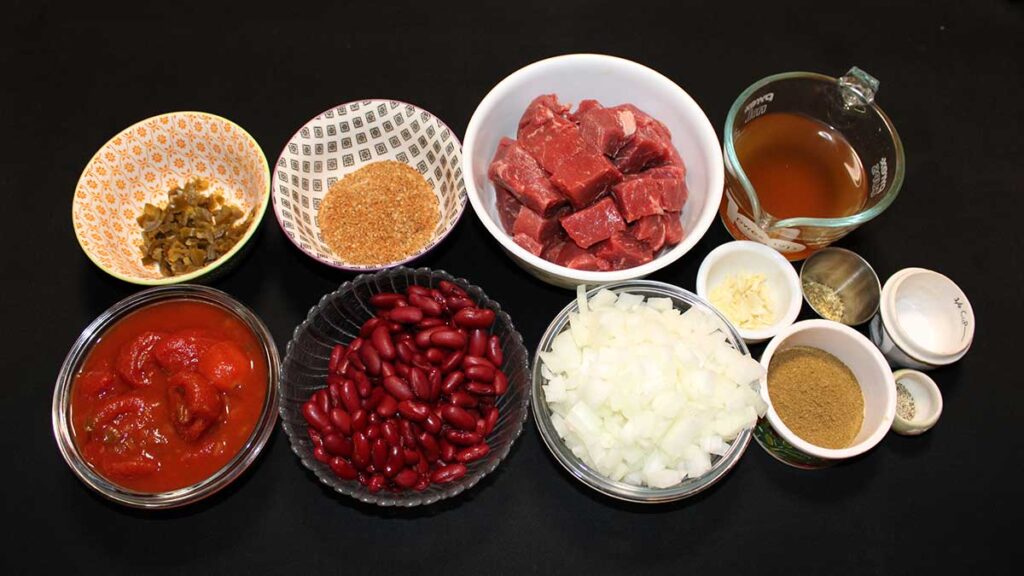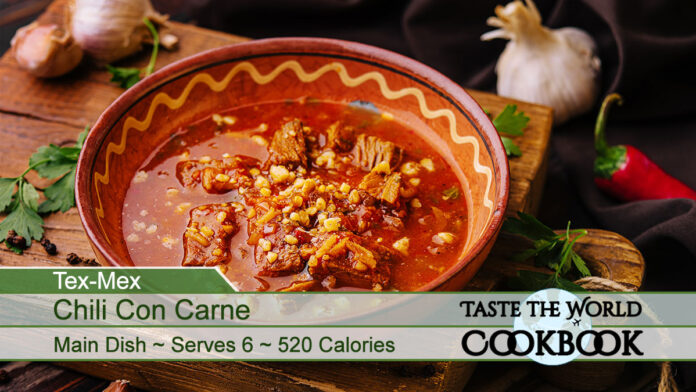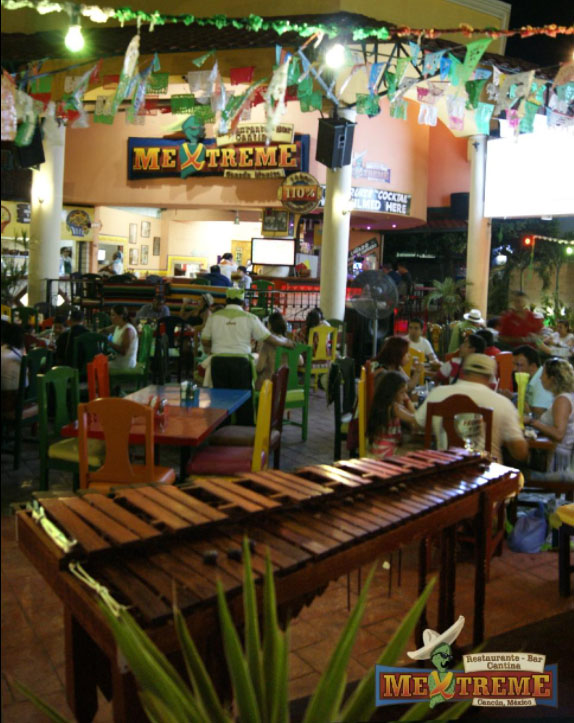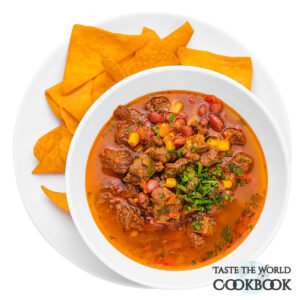Dive into the heart of Texan cuisine with a dish that captures the city’s vibrant spirit – San Antonio’s Fiesta Chili Con Carne. Today we’re spicing things up a notch, turning the heat up with a hearty meal beloved across the Lone Star State. A chili so festive and flavorsome, it encapsulates the soulful essence of San Antonio, a city that thrives on rich cultural heritage, lively festivals, and a deep-seated love for food.
The Chili Con Carne is a culinary celebration, boasting robust flavors and a pleasing warmth that comforts your palate and heart. This recipe invites you into the world of Texan gastronomy, showing you how simple ingredients, when assembled with care and understanding, can create a dish that’s nothing short of a party on a plate. So, fasten your apron, arm yourself with a ladle, and join us on this gastronomic adventure.
The beauty of Chili Con Carne lies not only in its rich taste but also in its versatility. Whether it’s a cozy family dinner or a bustling block party, this dish fits right in, promising a bowlful of delight. As we delve into the nuances of Chili Con Carne, we aim to do more than just list out the recipe steps. We hope to offer you a holistic perspective of the dish, a view of its origins, variations, and ties to its hometown, San Antonio.
Table of contents
- Crafting Chili: From Simple Stew to Culinary Masterpiece
- The Magic of San Antonio: An Urban Oasis in the Heart of Texas
- Mastering the Art of San Antonio’s Fiesta Chili Con Carne: A Step-by-step Guide
- Complementing Your Chili: Exploring the Perfect Culinary Companions for San Antonio’s Fiesta Chili Con Carne
Crafting Chili: From Simple Stew to Culinary Masterpiece
Chili Con Carne is a chameleon of sorts, effortlessly adapting to local tastes and preferences. Across Texas, you will find myriad versions, each with its distinct charm. Some swear by the traditional “Bowl o’ Red,” which features a simple yet powerful concoction of beef and chili peppers. On the other hand, you may come across chili laden with beans or even a vegetarian variant bursting with fresh vegetables and hearty legumes.
Venture further afield, and the variations keep coming. For instance, Cincinnati-style chili adds an unexpected twist, layering spiced meat sauce over spaghetti. On the other hand, white chili opts for chicken and white beans, offering a lighter, creamier alternative. Regardless of the version, one thing remains constant – chili’s ability to comfort and satisfy, making it a beloved dish across the United States.
But what sets San Antonio’s Fiesta Chili Con Carne apart? It lies in the artful balance of flavors, the careful selection of spices, and the slow-cooking method that allows the ingredients to meld together beautifully. This isn’t just another bowl of chili; it’s a culinary representation of San Antonio’s festive spirit and vibrant culture.
Preserving the Aroma: The Best Practices for Storing Chili
Making a large batch of San Antonio’s Fiesta Chili Con Carne is a good idea, especially when it comes to storage and meal planning. As with many stews, chili often tastes better the next day, as the flavors have had time to develop and intensify. To store, simply allow your chili to cool completely before transferring it into airtight containers.
In the refrigerator, your chili should stay fresh for up to four days. For longer-term storage, consider freezing it. Chili freezes well and can be stored in the freezer for up to three months without losing its taste or texture. Just remember to portion your chili into manageable sizes before freezing, for convenient thawing and reheating.
When you’re ready to enjoy your chili, thaw it overnight in the refrigerator if it’s frozen. Then, reheat it gently on the stove, adding a bit of water or broth if it’s too thick. With these storage tips, you can ensure that a delicious, homemade meal is always just a few steps away, saving you time and effort on busy days.
Chili Chronicles: The History and Impact of this Texan Staple
Chili con Carne’s story begins long before Texas was even a state. The dish’s roots trace back to the Spanish Canary Islanders who settled in San Antonio in the early 18th century. Their traditional dish, “Carne con Chili,” was a spicy stew of meat, tomatoes, and chili peppers. Over time, this recipe evolved into what we know today as Chili con Carne.
Throughout the 19th century, chili became increasingly popular in Texas, especially in San Antonio. By the late 1800s, “Chili Queens” had become a fixture in the city’s plazas, attracting locals and tourists alike with their fragrant pots of chili. These women played a crucial role in popularizing the dish and are often credited with helping establish San Antonio as a culinary destination.
Today, chili holds a special place in Texan culture. It was designated the state’s official dish in 1977, and each year, thousands flock to the city of Terlingua for the famed Chili Cook-off. Despite these modern traditions, the heart of chili con Carne remains in San Antonio, a testament to the city’s enduring culinary influence.
The Magic of San Antonio: An Urban Oasis in the Heart of Texas
San Antonio, the seventh-largest city in the United States, is a fascinating blend of the past and the present. The city’s history stretches back for more than 300 years, leaving it steeped in rich traditions and cultural influences from Native American, Spanish, Mexican, and Western heritages. Today, it’s a bustling metropolis filled with vibrant nightlife, thriving arts, and a culinary scene to rival any in the country.
Straddling South and Central Texas, San Antonio serves as a gateway to the American Southwest. The city’s urban landscape is a testament to its continued growth and development. Yet, despite its modern trappings, San Antonio clings to its roots. The city’s historic sites, such as the Alamo and the Spanish Missions, serve as stark reminders of its storied past and provide a captivating contrast against the city’s contemporary skyline.
However, San Antonio’s charm extends beyond its historical landmarks. The city is well-known for its warm hospitality, often expressed through its food. As such, a culinary journey through San Antonio provides an intimate glimpse into its multicultural heritage, encapsulated in its fusion of flavors and cooking styles.
Delving into San Antonio’s Past: A Historical Overview
In the annals of time, long before San Antonio was known by its current name, the land was a tapestry of diverse Native American cultures. These pre-Columbian societies, including the Payaya people, thrived on the resources offered by the region’s rivers and fertile soil. They cultivated maize, hunted game, and built complex societies, leaving behind a rich archaeological legacy that echoes their stories.
The transition from these ancient cultures to a new era began with the arrival of Spanish missionaries in 1718. This marked the genesis of San Antonio as the second-oldest European-founded city in the U.S. The name San Antonio, chosen by these missionaries, paid homage to Saint Anthony of Padua, ushering in a period of profound change for the region.
Throughout the 19th century, San Antonio found itself at the center of several pivotal events. The Battle of the Alamo in 1836, a crucial event in the Texas Revolution, etched the city’s name in the annals of Texan history. Post-independence, San Antonio transformed into a thriving hub for cattle ranching and distribution.
San Antonio stepped into the modern era with the advent of railroads in the late 19th century. This development fast-tracked its growth into a bustling city, creating a unique blend of old and new. Today, San Antonio stands as a growing metropolis, where diverse industries thrive alongside beautifully preserved historical sites, traditional festivals, and iconic cuisine, each element bearing testament to its rich history and multifaceted heritage.
The Attractions of Alamo City: A Tourist’s Guide to San Antonio
San Antonio, with its blend of rich history and modern attractions, is a magnet for tourists. The city’s main draw is undoubtedly the Alamo, a UNESCO World Heritage Site that stands as a testament to Texas’ struggle for independence. Just a stone’s throw away is the famous River Walk, a picturesque network of walkways along the San Antonio River lined with shops, restaurants, and nightclubs.
Beyond the city center, San Antonio boasts a host of other attractions. Nature lovers can explore the Natural Bridge Caverns or enjoy a safari adventure at the San Antonio Zoo. For those with an interest in art and culture, the San Antonio Museum of Art and the vibrant Pearl District offer numerous opportunities for exploration and discovery.
Yet, the city’s appeal isn’t limited to its attractions. For many visitors, San Antonio’s culinary scene is a significant part of its allure. From Tex-Mex and BBQ to craft beer and artisanal coffee, the city offers a gastronomic experience as diverse and vibrant as its cultural heritage.
The Taste of Texas: Exploring San Antonio’s Culinary Landscape
The cuisine of San Antonio is as diverse and rich as the city itself, offering a unique blend of flavors that reflect its multicultural history. The city’s culinary scene is renowned for its mix of Tex-Mex, authentic Mexican, traditional Texas barbecue, and innovative contemporary fare.
Tex-Mex is a staple in San Antonio, with dishes like enchiladas, fajitas, and tamales taking center stage. Yet, it’s the city’s traditional Texas barbecue – slow-smoked meats slathered in tangy-sweet sauce – that truly symbolizes its culinary identity. Of course, no mention of San Antonio’s cuisine would be complete without its chili – a dish so iconic it’s often referred to as the “soup of Texas.”
Beyond its traditional dishes, San Antonio’s food scene is continuously evolving, with a new wave of chefs and restaurants pushing culinary boundaries. From farm-to-table eateries to gourmet food trucks, the city offers an exciting culinary landscape for foodies to explore. At the heart of it all, however, remains the city’s commitment to soulful, flavorful cooking – a characteristic that defines San Antonio’s Fiesta Chili Con Carne.
– Featured Restaraunt –
Rosario’s ComidaMex & Bar
722 S St Mary’s St, San Antonio, TX 78205
Rosario’s made-from-scratch menu features locally sourced ingredients and tried-and-true recipes that generations of San Antonio families have come to love. Described by Wong as “Mexican comfort food,” the menu combines traditional Mexican dishes and original house specialties. Popular dishes include savory shrimp nachos, fresh fish tacos, and ceviche, a variety of piping hot enchilada plates, sizzling parrillas, and the restaurant’s award-winning fire-roasted salsa and chips.
Mastering the Art of San Antonio’s Fiesta Chili Con Carne: A Step-by-step Guide
Crafting a batch of San Antonio’s Fiesta Chili Con Carne is an exercise in patience and passion. This dish isn’t one to be rushed; instead, it calls for a slow simmer that allows the flavors to marry beautifully. It’s a labor of love, resulting in a stew that is both hearty and soulful.
Begin by sourcing the best ingredients. Quality is key in a dish as simple as chili con Carne. Opt for fresh chili peppers, well-marbled beef, and aromatic spices. Each ingredient plays a crucial role in the overall flavor profile of the dish.
Next comes the cooking process. Start by browning the beef to develop a rich, savory base. Then add the aromatics and spices, followed by the tomatoes and broth. Allow the chili to simmer gently until the beef is tender and the flavors are well blended. The result is a bowl of chili that is intensely flavorful, warming, and satisfying – a true representation of San Antonio’s culinary heritage.
Your Kitchen Companion: The Essentials for Crafting Fiesta Chili Con Carne
To embark on the culinary adventure of making San Antonio’s Fiesta Chili Con Carne, you’ll need a few essential kitchen tools and ingredients. Arm yourself with a sturdy pot, a sharp knife, a cutting board, and a ladle. As for the ingredients, be ready with your choice of cuts of beef, fresh produce, and aromatic spices. Follow our recipe closely, and soon, you’ll be savoring a taste of San Antonio in your own kitchen.

Equipment Needed
- 1 Dutch Oven or Large Cooking Pot
- 1 Sharp Knife
- 1 Stirring Spoon
Ingredients Needed
- 2 lbs beef chuck cut into 1/2-inch cubes
- 1 large red onion chopped
- 4 cloves garlic minced
- 3 tbsp chili powder
- 2 tsp ground cumin
- 1 tsp dried oregano
- 1 tsp salt
- 1/2 tsp black pepper
- 14 oz diced tomatoes
- 1-2 jalapenos seeded and finely chopped (adjust according to taste)
- 1 cup beef broth
- 15 oz kidney beans drained and rinsed (optional, not traditionally included in Texas chili but can be added if desired)
- cheddar cheese for garnish
- sour cream for garnish
- green onions for garnish
Time needed: 2 hours and 20 minutes
Cooking Directions for Chili Con Carne
- Brown the Beef
Heat a large pot over medium-high heat and add the 2 lbs beef chuck. Cook until browned on all sides. Remove the beef from the pot and set aside.
- Saute the Vegetables
In the same pot, add the 1 large red onion and cook until softened. Add the 4 cloves garlic, 3 tbsp chili powder, 2 tsp ground cumin, 1 tsp dried oregano, 1 tsp salt, and 1/2 tsp black pepper, and stir for about a minute until the spices are well incorporated.
- Add the Tomatoes
Return the beef to the pot. Add the 14 oz diced tomatoes, 1-2 jalapenos, and 1 cup beef broth. Stir well.
- Reduce the Heat and Simmer
Reduce the heat to low, cover the pot, and simmer for about 2 hours, or until the beef is tender. Stir occasionally and add additional broth or water if needed.
- Add the Beans
If using, add the 15 oz kidney beans to the pot and stir. Cook for another 10-15 minutes until the beans are heated through.
Serve the chili hot, garnished with cheddar cheese, sour cream, and green onions if desired. - Garnish and Serve
Serve the chili hot, garnished with cheddar cheese, sour cream, and green onions if desired.
San Antonio’s Fiesta Chili Con Carne
Please Rate this Recipe
Equipment
- 1 Dutch Oven or Large Cooking Pot
- 1 Sharp Knife
- 1 Stirring Spoon
Ingredients
Chili
- 2 lbs beef chuck cut into 1/2-inch cubes
- 1 large red onion chopped
- 4 cloves garlic minced
- 3 tbsp chili powder
- 2 tsp ground cumin
- 1 tsp dried oregano
- 1 tsp salt
- 1/2 tsp black pepper
- 14 oz diced tomatoes
- 1-2 jalapenos seeded and finely chopped (adjust according to taste)
- 1 cup beef broth
- 15 oz kidney beans drained and rinsed (optional, not traditionally included in Texas chili but can be added if desired)
Garnish
- cheddar cheese grated
- sour cream
- green onions chopped
Instructions
- Heat a large pot over medium-high heat and add the 2 lbs beef chuck. Cook until browned on all sides. Remove the beef from the pot and set aside.
- In the same pot, add the 1 large red onion and cook until softened. Add the 4 cloves garlic, 3 tbsp chili powder, 2 tsp ground cumin, 1 tsp dried oregano, 1 tsp salt, and 1/2 tsp black pepper, and stir for about a minute until the spices are well incorporated.
- Return the beef to the pot. Add the 14 oz diced tomatoes, 1-2 jalapenos, and 1 cup beef broth. Stir well.
- Reduce the heat to low, cover the pot, and simmer for about 2 hours, or until the beef is tender. Stir occasionally and add additional broth or water if needed.
- If using, add the 15 oz kidney beans to the pot and stir. Cook for another 10-15 minutes until the beans are heated through.
- Serve the chili hot, garnished with cheddar cheese, sour cream, and green onions if desired.
Notes
- The type of beef used matters. Beef chuck, as mentioned in the recipe, is ideal for its fat content and flavor.
- Chili con carne is traditionally a no-bean zone in Texas. If you prefer your chili with beans, we’ve included it as an optional ingredient.
- Customize the heat by adjusting the quantity of jalapenos to your taste.
- Garnishes aren’t just for looks – they add an extra layer of flavor. Grated cheddar cheese, sour cream, and green onions are highly recommended.
- Remember to stir occasionally during the simmering process to prevent sticking and ensure even cooking.
- San Antonio’s Fiesta Chili Con Carne can be made ahead and tastes even better the next day when the flavors have had more time to meld together.
- Enjoy this dish as is, or serve it over rice or with a side of cornbread for a complete meal.
Nutrition
Complementing Your Chili: Exploring the Perfect Culinary Companions for San Antonio’s Fiesta Chili Con Carne
San Antonio’s Fiesta Chili Con Carne pairs wonderfully with a variety of dishes. It’s a versatile stew that can take center stage or work as a complementary dish. If you’re planning a Texan-themed meal, consider other Lone Star classics like cornbread, coleslaw, or smoked brisket.
A meal inspired by San Antonio’s vibrant culinary scene is more than just a feast for your taste buds; it’s a journey into the heart of a city with a rich and diverse food culture. As you explore these recipes, we hope you find inspiration in the city’s gastronomic heritage and the enduring appeal of its beloved chili con Carne.
To conclude, San Antonio’s Fiesta Chili Con Carne is more than a dish; it’s a culinary tradition that captures the city’s spirit. As you stir the pot, you’re not just making a meal; you’re partaking in a centuries-old practice, bringing a piece of San Antonio into your home. So the next time you crave something warm, hearty, and full of history, why not reach for a bowl of San Antonio’s Fiesta Chili Con Carne? It’s more than just a recipe; it’s a taste of Texas heritage.
If you liked this dish please Rate This Recipe and leave a comment.





